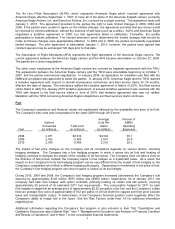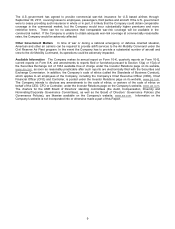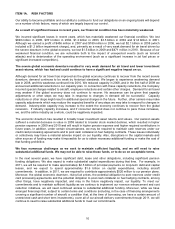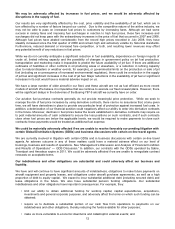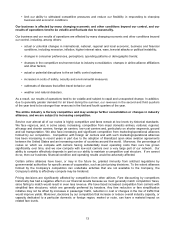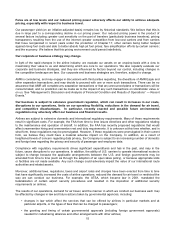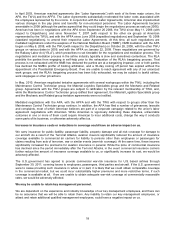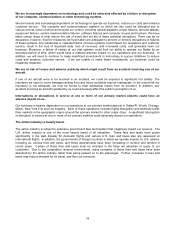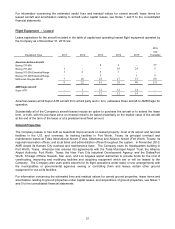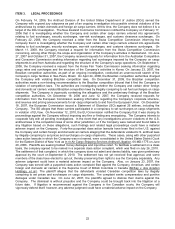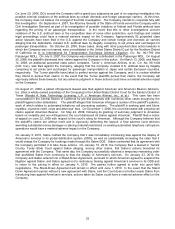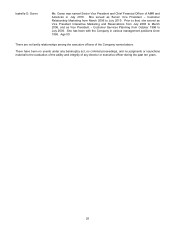American Airlines 2010 Annual Report Download - page 18
Download and view the complete annual report
Please find page 18 of the 2010 American Airlines annual report below. You can navigate through the pages in the report by either clicking on the pages listed below, or by using the keyword search tool below to find specific information within the annual report.
15
Fares are at low levels and our reduced pricing power adversely affects our ability to achieve adequate
pricing, especially with respect to business travel.
Our passenger yield (on an inflation-adjusted basis) remains low by historical standards. We believe that this is
due in large part to a corresponding decline in our pricing power. Our reduced pricing power is the product of
several factors including: greater cost sensitivity on the part of travelers (particularly business travelers); pricing
transparency resulting from the use of the internet; greater competition from low-cost carriers and from carriers
that have reorganized in recent years under the protection of Chapter 11; other carriers being better hedged
against rising fuel costs and able to better absorb high jet fuel prices; fare simplification efforts by certain carriers;
and the economy. We believe that this pricing environment could persist indefinitely.
Our corporate or business strategy may change.
In light of the rapid changes in the airline industry, we evaluate our assets on an ongoing basis with a view to
maximizing their value to us and determining which are core to our operations. We also regularly evaluate our
corporate and business strategies, and they are influenced by factors beyond our control, including changes in
the competitive landscape we face. Our corporate and business strategies are, therefore, subject to change.
AMR is considering, and may engage in discussions with third parties regarding, the divestiture of AMR Eagle and
other separation transactions, and may decide to proceed with one or more such transactions. There can be no
assurance that AMR will complete any separation transactions or that any announced plans or transactions will be
consummated, and no prediction can be made as to the impact of any such transactions on stockholder value or
on us. See “Management’s Discussion and Analysis of Financial Condition and Results of Operations” — Recent
Events.”
Our business is subject to extensive government regulation, which can result in increases in our costs,
disruptions to our operations, limits on our operating flexibility, reductions in the demand for air travel,
and competitive disadvantages. In particular, recently enacted and possible future environmental
regulations may adversely affect our business and financial results.
Airlines are subject to extensive domestic and international regulatory requirements. Many of these requirements
result in significant costs. For example, the FAA from time to time issues directives and other regulations relating
to the maintenance and operation of aircraft. In addition, the FAA has recently proposed regulations that would
affect crewmember hiring and crewmember rest and duty requirements. It is unknown at this time whether, and in
what form, these regulations may be promulgated. However, if these regulations were promulgated in their current
form, we believe they could have a material adverse impact on the Company. In addition, as a result of
heightened levels of concern regarding data privacy, the Company is subject to an increasing number of domestic
and foreign laws regarding the privacy and security of passenger and employee data.
Compliance with regulatory requirements drives significant expenditures and has in the past, and may in the
future, cause disruptions to our operations. In addition, the ability of U.S. carriers to operate international routes is
subject to change because the applicable arrangements between the U.S. and foreign governments may be
amended from time to time (such as through the adoption of an open skies policy), or because appropriate slots
or facilities are not made available. Any such change could adversely impact the value of our international route
authorities and related assets.
Moreover, additional laws, regulations, taxes and airport rates and charges have been enacted from time to time
that have significantly increased the costs of airline operations, reduced the demand for air travel or restricted the
way we can conduct our business. For example, the ATSA, which became law in 2001, mandated the
federalization of certain airport security procedures and resulted in the imposition of additional security
requirements on airlines.
The results of our operations, demand for air travel, and the manner in which we conduct our business each may
be affected by changes in law and future actions taken by governmental agencies, including:
•
changes in law which affect the services that can be offered by airlines in particular markets and at
particular airports, or the types of fees that can be charged to passengers;
•
the granting and timing of certain governmental approvals (including foreign government approvals)
needed for codesharing alliances and other arrangements with other airlines;




